
Meetings supported by VarSITI and its projects in 2016
REPORTS
IAU Symposium 327, "Fine Scale Structure and Dynamics of the Solar Atmopshere"
9÷14, 2016 October, Cartagena de Indias, Colombia ![]()
XIVth Hvar Astrophysical Colloquium, "Solar and Solar-Terrestrial Physics: Now and in the Future"
26÷30 September 2016, Hvar, Croatia ![]()
VLF/ELF Remote Sensing of Ionospheres and Magnetospheres,
19÷24 September 2016, Hermanus, South Africa ![]()
9th IAGA-ICMA/IAMAS-ROSMIC/VarSITI/SCOSTEP workshop on "Long-Term Changes and Trends in the Atmosphere", 19÷23 September 2016, Kühlungsborn, Germany ![]()
International Symposium on the Whole Atmosphere (ISWA),
14÷16 September 2016, Tokyo, Japan ![]()
International Symposium on Recent Observations and Simulations of the Sun-Earth System III,
11÷16 September 2016, Golden Sands, Bulgaria ![]()
6th IAGA/ICMA/SCOSTEP Workshop on Vertical Coupling in the Atmosphere-Ionosphere System,
25÷29 July, 2016, Taipei, Taiwan
The 6th International HEPPA-SOLARIS Workshop, 13÷17 June, 2016, Helsinki, Finland
The First VarSITI General Symposium, 6÷10 June 2016, Albena, Bulgaria
JpGU2016 Space Weather, Space Climate and VarSITI session, 22÷23 May 2016, Makuhari, Japan
Session of Extreme Space Weather Events EGU 2016, April 17÷22, 2016, Vienna, Austria
3rd International Science Workshop Antarctic Gravity Wave Instrument Network (ANGWIN),
12÷14 April 2016, Cambridge, UK
Space Climate School and Space Climate Symposium, 30 March - 7 April 2016, Levi, Finland
SCOSTEP/COSPAR/ILWS 2016 “Science for Space Weather” Workshop, 24-29 January 2016, Goa, India
3rd International Annual Conference of the Nigerian Geophysical Society, 2–5 February, 2016, Kwara State, Nigeria
4th International Symposium (IAGA-IV) “Influence of short and long term solar variability on climate”,
March 20-24, 2016, Hurghada, Egypt
VarSITI Newsletter Nov. 2016
IAU Symposium 327
"Fine Scale Structure and Dynamics of the Solar Atmopshere"
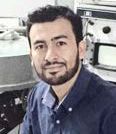 Santiago Vargas Dominguez
Santiago Vargas Dominguez
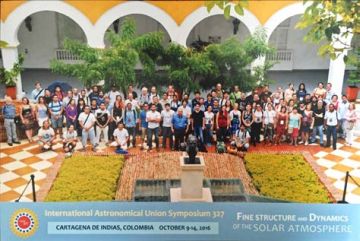 Group photo of participants
Group photo of participantsIAU Symposium 327 entitled Fine Structure and Dynamics of the Solar Atmosphere was the first IAU symposium held in Colombia and took place immediate after the XV Latin American Regional IAU Meeting (LARIM, 2-7 October 2016) and the First Workshop on Astronomy Beyond the Common Senses for Accessibility and Inclusion (8 October 2016). The venue was the University of Cartagena located within the walled city of Cartagena de Indias.
The main scientific goal of this symposium was to discuss recent results on the processes shaping the structure of the solar atmosphere and driving plasma eruptions and explosive events.
This symposium brought together researchers, in both theory and observation. A total of 76 scientists and students (27 female / 49 male) from 19 countries participated in IAUS327. The VarSITI program was a co-sponsor of the symposium and partially supported the participation of students.
VarSITI Newsletter Nov. 2016
XIVth Hvar Astrophysical Colloquium
"Solar and Solar-Terrestrial Physics:
Now and in the Future"
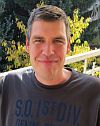 Domagoj Ruzdjak
Domagoj Ruzdjak
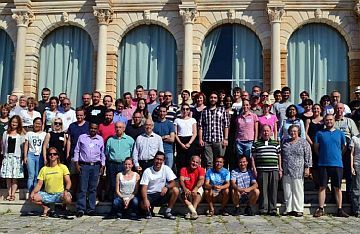 Group photo of participants
Group photo of participantsThe Hvar Astrophysical Colloquium series of conferences is organized every 2 years and represents the most important solar physics event in Croatia, due to the aim of bringing together researchers from Europe and beyond which are active in the theoretical and observational study of all solar phenomena. The 14th Hvar Astrophysical Colloquium "Solar and Solar-Terrestrial Physics: Now and in the Future" was held on 26÷30 September, 2016 in Hvar, Croatia and covered a broad range of topics
| 1) activity of the Sun and solar-like stars, 2) eruptive processes in the solar atmosphere, 3) solar terrestrial connection and the heliosphere, | 4) space weather and space climate forecasting, and 5) observing techniques campaigns and databases. |
At the meeting participated 75 scientists from 17 countries, and 10 invited, 60 contributed talks and 14 posters was presented.
A special issue of the Central European Astrophysical Bulletin is planned based on the papers presented at the Colloquium.
VarSITI Newsletter Nov. 2016
7th VERSIM Workshop VLF/ELF Remote Sensing of
Ionospheres and Magnetospheres
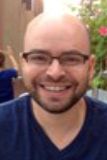 Jacob Bortnik
Jacob Bortnik
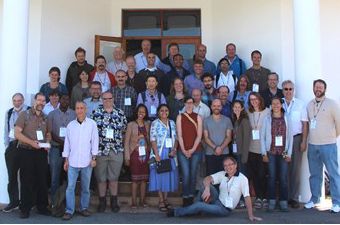 Group photo of participants
Group photo of participantsThe 7th workshop of the URSI/IAGA Joint Working Group on ELF/VLF Remote Sensing of Ionospheres and Magnetospheres (VERSIM) took place in Hermanus, South Africa, over the period 19÷24 September 2016.
The workshop attracted 55 participants from 16 different countries and, in large part due to support from SCOSTEP/VarSITI, was able to support 11 individuals who were either young scientists (5), or came from developing countries (6).
There were 69 abstracts received, 59 of which could be accommodated as orals, and 10 of which as posters. More information on presenters and abstracts can be found on the abstract webpage: https://events.sansa.org.za/abstracts.
The abstracts were organized into 6 days, the first 4 days of which were devoted to core VERSIM topics (including D-region, lightning, whistlers, plasmasphere, chorus and EMIC waves) and the last 2 days transitioned into more of a radiation-belt focus.
The VERSIM scientific program can be found here: https://events.sansa.org.za/versim-programme.
VarSITI Newsletter Nov. 2016
9th IAGA-ICMA/IAMAS-ROSMIC/VarSITI/SCOSTEP workshop on
"Long-Term Changes and Trends in the Atmosphere"
 Franz-Josef Lübken
Franz-Josef Lübken
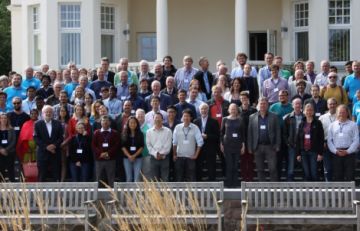 Group photo of participants
Group photo of participantsThe well established biannual workshop on 'LongTerm Changes and Trends in the Atmosphere'
took place from 19 to 23 September 2016 at the Leibniz Institute of Atmospheric Physics (IAP) in Kühlungsborn.
The most important topics covered during the workshop were:
1. Observed trends and long term variations in the middle atmosphere
2. Modeled and predicted trends and long term variations in the middle atmosphere
3. Trends and long-term changes in the ionosphere and thermosphere
4. Dynamic, physical, chemical and radiative mechanisms of trends and long term variations
5. Role of the middle atmosphere for climate
6. Trends in the entire atmosphere being relevant for the German research project ROMIC (Role Of the Middle Atmosphere In Climate)
A total of 104 scientists and students from 16 countries participated in this workshop. This is the largest attendance in this series starting in 1999. The workshop was also organized as a ROMIC symposium to present and discuss results from this German program within an international community.
A total of 74 oral talks and 17 posters highlighted the actual status and recent progress in our understanding of trends and long term variations, e. g. by solar variability, from the Earth's surface to the upper thermosphere. Anthropogenic effects as well as variations due to the eleven year solar cycle and other sources of natural variability were discussed. Both measurements of various atmospheric parameters and results from different models were presented. There was consensus to publish the results from this workshop in a special issue of an international peer reviewed journal, namely Journal of Atmospheric and Solar-Terrestrial Physics.
The workshop was co-sponsored by IAGA, ICMA/IAMAS, the ROSMIC program of VarSITI (SCOSTEP), the German Space Agency (DLR), the IAP institute, and the German ROMIC research initiative of BMBF.
VarSITI Newsletter Nov. 2016
International Symposium on the Whole Atmosphere (ISWA)
 Kaoru Sato
Kaoru Sato
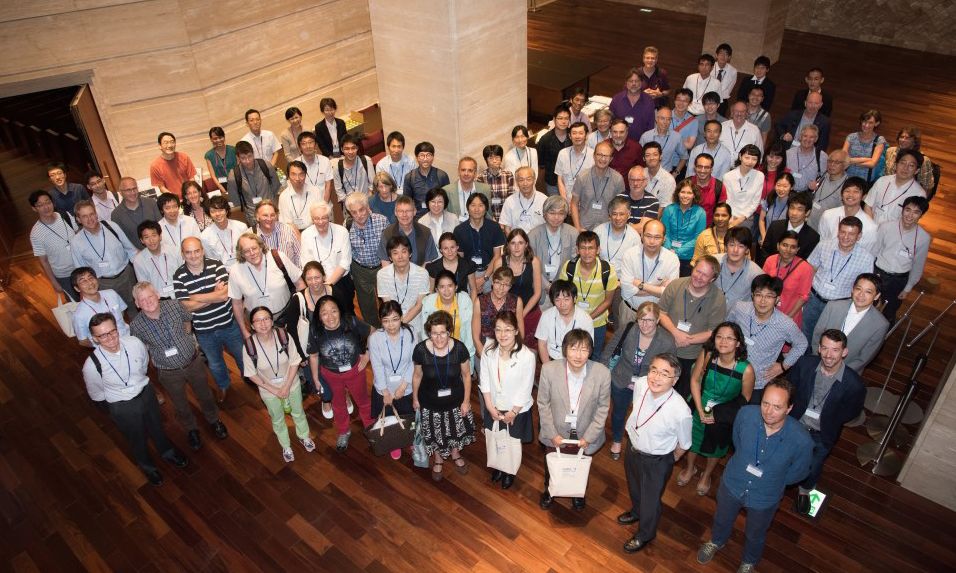 Group photo of participants
Group photo of participantsThe International Symposium on the Whole Atmosphere (ISWA) was organized by School of Science, the University of Tokyo and National Institute of Polar Research, and held at Ito Hall of the University of Tokyo on 14÷16 September 2016. A total of 118 scientists and students from 14 countries participated in the symposium and reported their latest research regarding the whole atmosphere, particularly focusing on the dynamics of the middle and upper atmosphere. Research topics covered in this symposium include vertical and intra/interhemispheric coupling, atmospheric waves such as Rossby waves, gravity waves and tides, wave-mean flow interaction, solar effects, observation technology, and high-resolution modeling. A side meeting concerning the Interhemispheric Coupling Study by Observations and Modeling (ICSOM; http://pansy.eps.s.u-tokyo.ac.jp/icsom/) was also held during the symposium, in which a preliminary result of the first ICSOM campaign performed in January-February 2016 was reported. It was also confirmed that the next ICSOM campaign will be conducted in January-February 2017. Many presentation files will be available online at the ISWA website (http://pansy.eps.s.u-tokyo.ac.jp/iswa/). A special issue of SOLA will be published with papers presented in the symposium. The VarSITI program was a cosponsor of the symposium and its sponsorship contributed to the partial support for 5 early career scientists to attend the symposium.
VarSITI Newsletter Nov. 2016
International Symposium on Recent Observations and Simulations of the Sun-Earth System III
 Vania K. Jordanova
Vania K. Jordanova
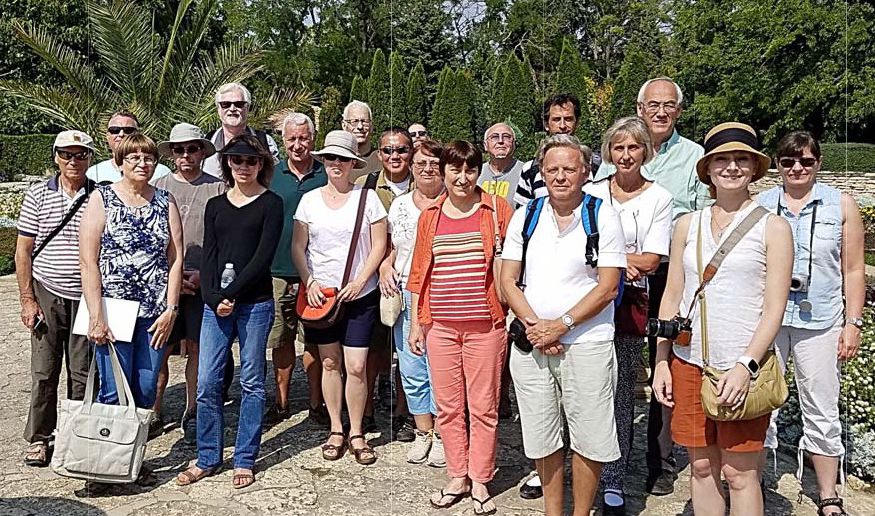 Group photo of participants
Group photo of participantsThe 3rd International Symposium on Recent Observations and Simulations of the Sun-Earth System (ISROSES-III) was held in Golden Sands, Bulgaria, from 11 to 16 September 2016. It created a forum for researchers from all space science communities worldwide to discuss the complex, multiscale, interactions in the Sun-Earth system.
The Symposium covered a broad range of topics: a) interactions and coupling within the Sun-Earth system, b) advances in measurement, data analysis, theory, and simulations of the Sun-Earth system, c) reaction of the Earth system to the Sun and the solar wind, and d) recent research in space weather science and applications. The ISROSES-III scientific program consisted of oral and poster sessions which gathered about 100 participants for fruitful discussions. Among the ISROSES-III participants were distinguished speakers from the US, European Union, Canada, China, Japan, Norway, Russia, and other countries.
For further information about the symposium, please visit the official website: http://www.isroses.lanl.gov/
SCOSTEP Newsletter Sept. 2016
6th IAGA/ICMA/SCOSTEP Workshop on Vertical Coupling in the Atmosphere-Ionosphere System
 Loren C. Chang
Loren C. Chang
 Workshop participants at the conference venue in Taipei
Workshop participants at the conference venue in TaipeiTo facilitate the community dialogue crucial to understanding how vertical coupling contributes to the overall variation of the Earth’s atmospheric system, the 6th Workshop on Vertical Coupling in the Atmosphere-Ionosphere System was held at Academia Sinica in Taipei, Taiwan from July 25÷29, 2016. This is the first time this Workshop has been held in East Asia, to encourage involvement of researchers in this region.
Participation included colleagues from 16 institutions across 9 countries, with over 40 abstracts received. Topics of interest included upper and middle atmosphere variability induced by atmospheric tides, planetary waves. Ionospheric variations due to solar eclipses, dust storms, earthquakes, and increasing carbon dioxide concentrations were also discussed.
A special edition of the Journal of Atmospheric and Solar-Terrestrial Physics is now open for submission until November 2016. Abstracts and the Workshop program are available online at: http://www.ss.ncu.edu.tw/~vcais6/program.html
Institute of Space Science,
National Central University, Taiwan
VarSITI Newsletter Vol.10
The 6th International HEPPA-SOLARIS Workshop
 P.T. Verronen
P.T. Verronen
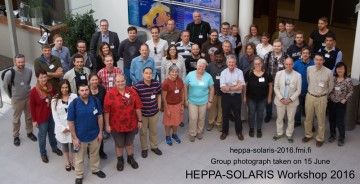 Group photo of participants.
Group photo of participants.The 6th International HEPPA-SOLARIS Workshop was held on 13-17 June, 2016, at the Finnish Meteorological Institute in Helsinki, Finland. The workshop continued the series of meetings organized since 2008 and focused on observational and modeling studies of the influences of solar radiation (SR) and energetic particle precipitation (EPP) on the atmosphere and climate. A total of 57 scientists participated from the following countries: Finland 14, USA 9, Germany 9, Norway 6, UK 5, Sweden 3, Greece 2, Spain 2, Switzerland 2, Czech Republic 1, Egypt 1, France 1, Japan 1, New Zealand 1.
A total of 65 presentations were given: 7 invited oral, 35 oral, 23 posters. The workshop was scientifically and financially sponsored by VarSITI/SCOSTEP, IAMAS/IUGG, and SPARC. The workshop web pages at http://heppa-solaris-2016.fmi.fi provide more information.
VarSITI Newsletter Vol.10
The First VarSITI General Symposium
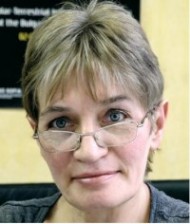 Katya Georgieva
Katya Georgieva
More than 100 scientists from 24 countries gathered in Albena, Bulgaria for the first VarSITI General Symposium (June 6-10, 2016), to overview the progress of various activities in the four VarSITI projects at the midpoint of the five-year program.
114 oral and poster scientific papers were presented in the 7 symposium sessions:

- Solar and Heliospheric Drivers of Earth-Affecting Events;
- Long-term Variation of the Sun and Climate;
- Understanding the Earth's space environment and its connection to space weather;
- Sun to Mud Campaign Study of March 15-17, 2015 Event and other significant events;
- Modeling the connection from Sun to Mud (and all steps in between);
- Data archiving;
- Special session on Heliospheric Cataloguing, Analysis and Technique Service (HELCATS).
The Book of Abstracts is available on Symposium’s site (here ![]() )
)
Many presentations are available online at http://newserver.stil.bas.bg/VarSITI2016/.
A special issue of JASTP will be published with papers based on the Symposium presentations, with promotional access (free for the authors, 9 months free to download).
VarSITI Newsletter Vol.10
JpGU2016 session
Space Weather, Space Climate and VarSITI
 Ryuho Kataoka
Ryuho Kataoka
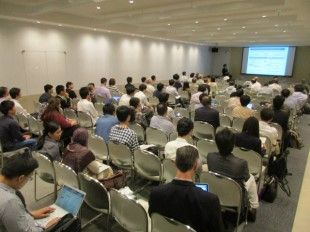 Photo from the session.
Photo from the session.JpGU2016 Space Weather, Space Climate, and VarSITI session was held on May 22-23 at Makuhari, Chiba, Japan. "Past, Present, and Future of Solar-Terrestrial Environment" is the keynote of this session. We shared the latest scientific papers to understand how the solar-terrestrial environment changes in various time scales, and discussed the necessary international collaboration projects associated with VarSITI. This session was cooperated with Project for Solar-Terrestrial Environment Prediction (PSTEP, PI: K. Kusano, Nagoya University). Further, this is the first trial of JpGU and AGU joint-session, and Dr. Antti Pulkkinen (NASA/GSFC) was invited as AGU-counterpart convener, thanks to the travel support from VarSITI fund. There were 33 talks and 32 posters, including the latest reports from PSTEP activities on Japanese space weather researches and operations, additional to NASA and NOAA activities.
VarSITI Newsletter Vol.10
Session of Extreme Space Weather Events EGU 2016
 Christine Amory-Mazaudier
Christine Amory-Mazaudier
The EGU General Assembly brought together 13,350 participants from 109 countries. Several session of EGU were merged in the Extreme Space Weather Event with six main communications and 16 posters were presented on Wednesday 20, 2016
Space Weather events and Statistics:D. Baker presented the extreme Space Weather Event of July 23, 2012 (Dst ~- 300nT). He noticed that the main factors that must be taken into account are the Solar wind speed and the Bz component of the Interplanetary Magnetic Field (IMF). With the ACE satellite it is possible to know one hour before the impact of a solar perturbation, its solar wind speed and its IMF Bz. D. Baker informed us also that in USA there is the SWAP: Space Weather Action Plan to prevent the possible damages on new technologies. Nikitina et al., presented a statistics of the extreme events for geomagnetic and geoelectric variations in Canada based on more than 40 years of magnetic data (1972-2013), with a time resolution of one minute. In this data set there is the extreme event of March 13, 1989, which was largely reported by the media and drew the attention of the population on Space Weather. Another communication by Rami Vainio et al., has focused on the extreme SEP (Solar Energetic Particles) events. Two events, those of October 1989 and July 2012 have been qualified as extreme space weather event. And again, the period of July 2012 was noticed.
Long term variations:Two other communications were interested in understanding the variations of spots cycle. Popova using an alpha omega dynamo model to interpret the long term oscillations of solar activity predicted large minima every few hundred of years. Yndestad and Solheim have interpreted some solar minima by the influence of gravity between the large planets of the solar system. They have explained the minimum of Dalton by the influence of Uranus and Neptune.
Finally, Thomas et al. have proposed a study on the Cosmic Rays. 90% of the Cosmic rays are protons of energy from 100 MeV to 100 GeV. The Cosmic Ray fluxes are modulated by the heliospheric magnetic field and have a 22 years cycle. The polarity + or - of the heliospheric magnetic field defines the trajectories of the CR.
VarSITI Newsletter Vol.10
3rd International Science Workshop Antarctic Gravity Wave Instrument Network (ANGWIN)
 Tracy Moffat-Griffin
Tracy Moffat-Griffin
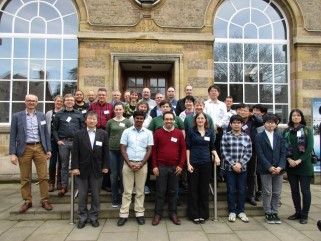 Group photo of the participants.
Group photo of the participants.The 3rd ANGWIN science workshop was organised by the British Antarctic Survey and held in Cambridge 12th-14th April 2016. We had 33 delegates at the meeting from 10 different countries. VarSITI were co-sponsors of the meeting and their sponsorship contributed to the provision of partial funding for 8 early career scientists to attend the workshop. We had a range of topics covered by presentations at the workshop; modelling studies of gravity waves in the Polar Regions, observational results from all regions of the atmosphere and also future instrumentation that will be deployed in the coming year. We had two fruitful discussion sessions where content for the new ANGWIN website (www.bas.ac.uk/projects/angwin) was discussed, future ANGWIN related publications planned and also future collaborative projects devised. It was a successful workshop and we are grateful to VarSITI for their support.
VarSITI Newsletter Vol.10
Space Climate School and Space Climate Symposium
 Kalevi Mursula
Kalevi Mursula
 T. Asikainen
T. Asikainen
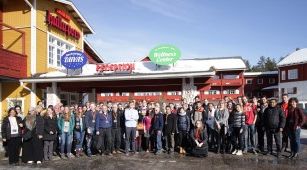 Group photo of the participants.
Group photo of the participants.The 2nd Space Climate School and the 6th Space Climate Symposium were organized in 30.3.÷7.4.2016 in Levi, Finnish Lapland, under the leadership of the ReSoLVE Centre of Excellence of the Academy of Finland. The School was targeted for PhD students and young researchers of solar-terrestrial sciences, and covered a unique selection of topics relevant for space climate studies, including several long-term datasets and various data analysis and statistical methods. The school had also several hands-on computer exercise sessions, where students practiced to use different online databases and analysis methods. The School had 18 internationally recognized experts as lecturers, and 50 students of 20 nationalities from 4 continents, a truly international setting. The school also offered excellent possibilities for networking between students and lecturers. The 6th Space Climate Symposium gathered 120 attendees of 35 nationalities to discuss the recent developments of space climate. The Symposium gave an extensive overview of a versatile selection of space climate topics, including solar dynamo, long-term solar activity, solar asymmetries, extreme events, solar corona and solar wind, the Earth’s magnetosphere and ionosphere, as well as solar influence on climate. In total there were 58 talks and 56 posters. A topical debate on sunspot numbers was organized, which sparked a lively discussion on different aspects of sunspot observations, and initiated a community action on homogenizing the sunspot number series into a physical parameter with time-varying error estimate. The program and presentations of the Space Climate School and Symposium are available at http://www.spaceclimate.fi
VarSITI Newsletter Vol.9
SCOSTEP/COSPAR/ILWS 2016
“Science for Space Weather”
 R. F.Wimmer-Schweingruber
R. F.Wimmer-Schweingruber
 Dibyendu Nandi
Dibyendu Nandi
 Group photo of the participants.
Group photo of the participants.Understanding and being able to forecast space weather is increasingly important for our modern technology-reliant society. This workshop treated all aspects of space weather, from solar origin of transient events to their propagation through the heliosphere and effects on Earth and other planetary bodies, from particle energization to forecasting the particle environment and its effects on technological and biological systems, as well as solar-cycle effects and coupling of space weather to atmospheric response. Metrics to assess predictions were also discussed.
105 participants (incl. 25 students) from 21 countries contributed 35 invited and 22 contributed talks, 47 posters, and participated in a lively panel discussion. The final workshop program can be found on the workshop web pages: http://www.cessi.in/ssw/. The workshop also included a two-day school for MSc- and PhD students which offered 15 overview talks and two hands-on tutorials on two afternoons. This workshop was sponsored by ILWS, SCOSTEP-VarSITI, COSPAR, ISRO, Physical Research Laboratory (Ahmedabad), Christian Albrechts University(Kiel) and CESSI-IISER Kolkata. For more information see: www.cessi.in/ssw/.
VarSITI Newsletter Vol.9
3rd International Annual Conference of
the Nigerian Geophysical Society
 E. O Falayi
E. O Falayi
 O. S Bolaji
O. S Bolaji
 Group photo of the participants.
Group photo of the participants.The 3rd Annual International Conference on Space-Earth Environment for National Sustainable Development organized by the Nigerian Geophysical Society was held at Landmark University, Omu-Aran, Kwara State, Nigeria between 2 nd and 5th February, 2016. In attendance, over 150 participants registered and participated in the 3rd conference, which include undergraduate and post-graduate students from 22 Higher Institutions of learning in Nigeria (Universities, Polytechnics and Colleges of Education). The meeting was successful with over 50 Oral Presentations covering almost all the areas of content. The conference has unveiled solutions to important problems in the area of Space Physics and Geophysics. The NGS appreciates the Landmark University, Scientific Committee on Solar Terrestrial Physics (SCOSTEP), Variability of the Sun and its Terrestrial Impact (VarSITI), National Space Research and Development Agency (NASRDA) and Atmospheric and Space Environment Research Network (ASPERN) for their support, which make the conference a successful one.
VarSITI Newsletter Vol.9
4th International Symposium (IAGA-IV)
“Influence of short and long term solar variability on climate”
 Ahmed A. Hady
Ahmed A. Hady
 Group photo of the participants.
Group photo of the participants.The Symposium held for the 4 th time, with about 70 attendances from nine centuries: Cameroon – Egypt – England - France – Germany – Mali – Morocco - Russia – Saudi Arabia.
Via the Symposium website: http://iaga.cu.edu.eg, we received 49 abstracts. The Scientific Organizing Committee selected 9 papers as review or invited speakers' one. In addition 15 papers were accepted as oral contributions and poster contributions included 25 papers. The scientific program of the Symposium has been divided into 6 scientific sessions distributed in 4 days as follows:
- Solar and Space missions for Space Weather and solar variability observations
- Solar activity/variability effects on the lower, middle and upper atmosphere
- Modeling climate consequences of solar activity influence and suggested mechanisms
- Modeling and predicting large flares, super flares, CMEs and other extreme events
- Solar energetic particles and Solar wind influence on the Earth's inner magnetosphere and atmosphere and
- Societal impact of solar variability, Education.
The articles issued from these presentations and posters, upon review, will be published in a special issue of the Cairo University Journal of Advanced Research, an Elsevier publication. Articles are expected in within three months after the Symposium, July 30, 2016 deadline.
